Practice Free SC-401 Exam Online Questions
HOTSPOT
You have a Microsoft 365 E5 subscription.
You need to ensure that users are prevented from uploading sensitive data to ChatGPT and Google Gemini.
The solution must meet the following requirements:
• Prevent credit card numbers from being pasted into ChatGPT and Gemini.
• Prevent documents that contain classified data from being uploaded to ChatGPT and Gemini.
Which Microsoft Purview solution should you use for each requirement? To answer, select the appropriate options in the answer area. NOTE: Each correct selection is worth one point.
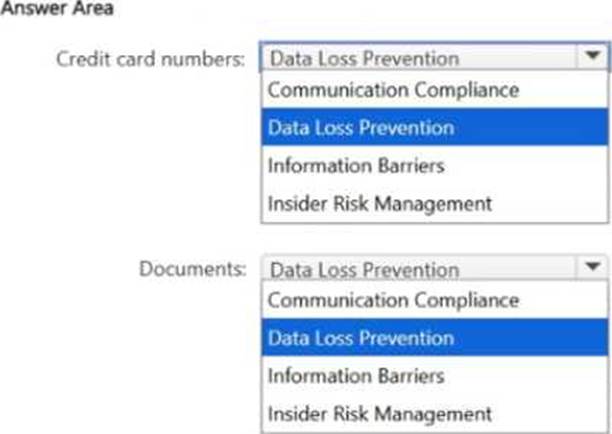
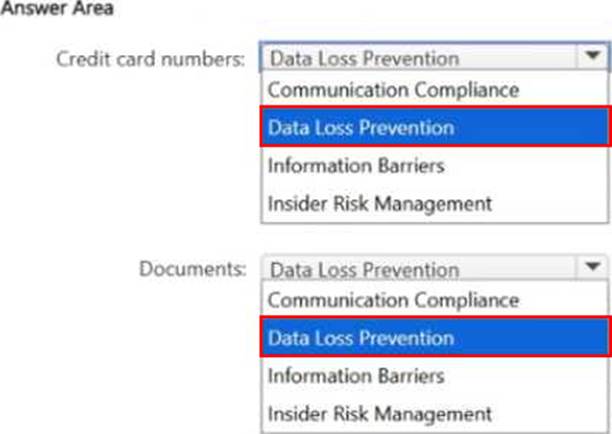
You have a Microsoft 365 E5 subscription that has a sensitivity label named Sensitivity1.
You plan to create an auto-labeling policy that will apply Sensitivity1 to Microsoft Exchange Online mailboxes.
On February 1, you create the auto-labeling policy and enable simulation mode by using the default settings. No modifications are made to the policy in simulation mode.
When will the policy first be turned on?
- A . February 2
- B . February 6
- C . February 15
- D . never
HOTSPOT
You have a Microsoft 365 E5 subscription that contains the device configurations shown in the following table.
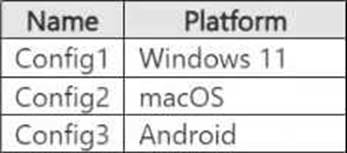
Each configuration uses either Google Chrome or Firefox as a default browser.
You need to implement Microsoft Purview and deploy the Microsoft Purview browser extension to the configurations.
To which configuration can each extension be deployed? To answer, select the appropriate options in the answer area. NOTE: Each correct selection is worth one point.

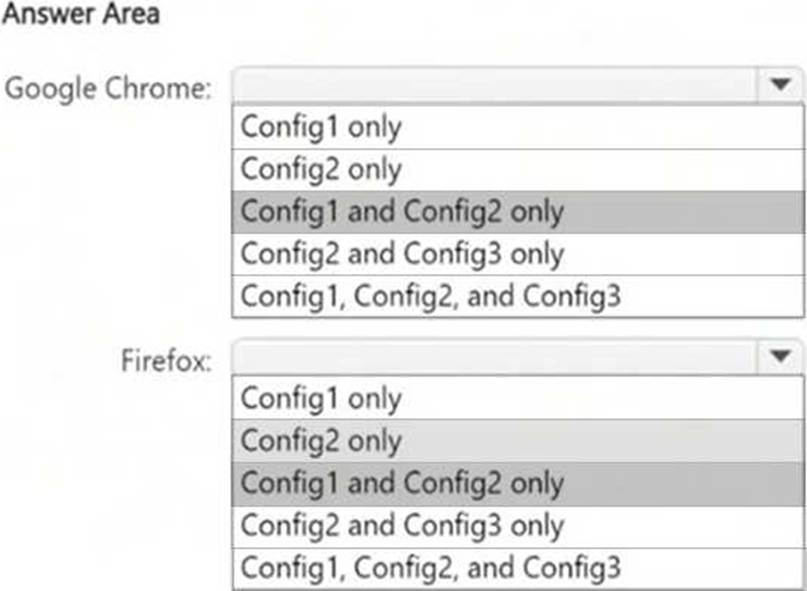
Explanation:
Microsoft Purview browser extensions for Endpoint DLP are supported on:
● Windows 10/11 (Config1)
● macOS (Config2)
● Not supported on Android (Config3)
Since Microsoft Purview does not support browser extensions on Android, Config3 is excluded from both Google Chrome and Firefox.
You have a Microsoft 365 subscription that contains two Microsoft SharePoint Online sites named
Site1 and Site2.
You plan to use policies to meet the following requirements:
• Add a watermark of Confidential to a document if the document contains the words Project1 or Project2.
• Retain a document for seven years if the document contains credit card information.
• Add a watermark of Internal Use Only to all the documents stored on Site2.
• Add a watermark of Confidential to all the documents stored on Site1.
You need to recommend the minimum number of sensitive info types required.
How many sensitive info types should you recommend?
- A . 1
- B . 2
- C . 3
- D . 4
You have a Microsoft 365 subscription.
You create a new trainable classifier.
You need to train the classifier.
Which source can you use to train the classifier?
- A . an on-premises Microsoft SharePoint Server site
- B . an A2ure Files share
- C . a Microsoft SharePoint Online site
- D . an NFS file share
HOTSPOT
You have a Microsoft 365 E5 subscription.
You need to implement a compliance solution that meets the following requirements:
● Captures clips of key security-related user activities, such as the exfiltration of sensitive company data.
● Integrates data loss prevention (DLP) capabilities with insider risk management.
What should you use for each requirement? To answer, select the appropriate options in the answer area. NOTE: Each correct selection is worth one point.

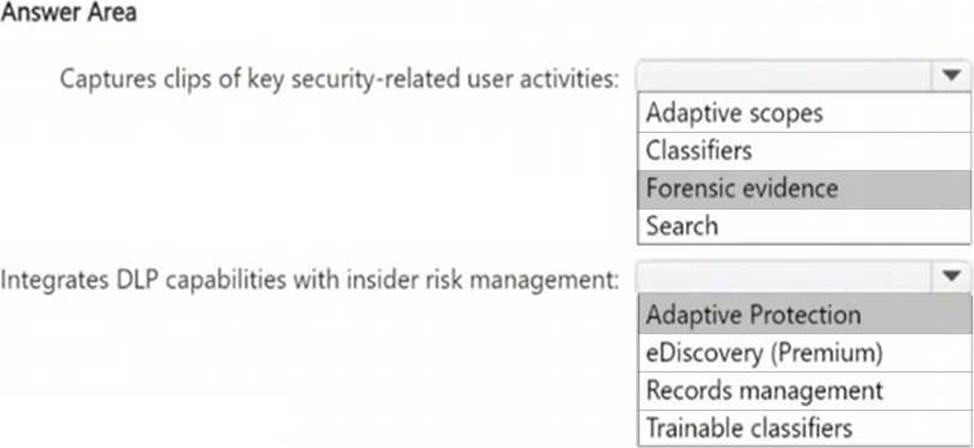
HOTSPOT
You have a Microsoft 365 E5 subscription.
You need to implement a compliance solution that meets the following requirements:
● Captures clips of key security-related user activities, such as the exfiltration of sensitive company data.
● Integrates data loss prevention (DLP) capabilities with insider risk management.
What should you use for each requirement? To answer, select the appropriate options in the answer area. NOTE: Each correct selection is worth one point.


You need to meet the technical requirements for the creation of the sensitivity labels.
To which user or users must you assign the Sensitivity Label Administrator role?
- A . Admin1 only
- B . Admin1 and Admin4 only
- C . Admin1 and Admin5 only
- D . Admin1, Admin2, and Admin3 only
- E . Admin1, Admin2, Admin4, and Admin5 only
D
Explanation:
To meet the requirement that all administrative users must be able to create Microsoft 365 sensitivity labels, we need to assign the Sensitivity Label Administrator role to the correct users.
Sensitivity Label Administrator Role Responsibilities
This role allows users to:
● Create and manage sensitivity labels in Microsoft Purview.
● Publish and configure auto-labeling policies.
● Modify label encryption and content marking settings.
Review of Admin Roles from the Table:
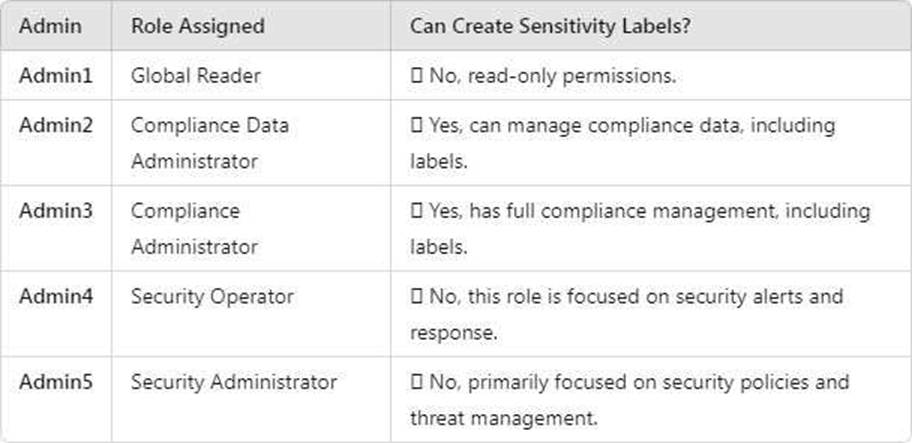
Users that must be assigned the Sensitivity Label Administrator role:
● Admin2 (Compliance Data Administrator)
● Admin3 (Compliance Administrator)
● Admin1 (Global Reader) (should be assigned this role to fulfill the requirement that all admins can create labels).
You have a Microsoft 365 E5 tenant that contains a user named User1. User1 is assigned the Compliance Administrator role. User1 cannot view the regular expression in the IP Address sensitive info type. You need to ensure that User! can view the regular expression.
What should you do?
- A . Assign Used to the Reviewer role group
- B . Create a copy of the IP Address sensitive info type and instruct User1 to edit the copy.
- C . Instruct User1 to use the Test function on the sensitive info type.
- D . Assign User1 the Global Reader role.
You have a Microsoft 365 E5 tenant that contains a user named User1. User1 is assigned the Compliance Administrator role. User1 cannot view the regular expression in the IP Address sensitive info type. You need to ensure that User! can view the regular expression.
What should you do?
- A . Assign Used to the Reviewer role group
- B . Create a copy of the IP Address sensitive info type and instruct User1 to edit the copy.
- C . Instruct User1 to use the Test function on the sensitive info type.
- D . Assign User1 the Global Reader role.
